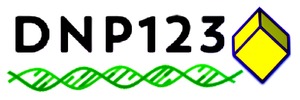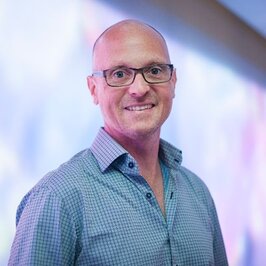Tell us a bit about yourself. What are you most passionate about? I am a science artist specialising in accurate biomedical animations of the molecular mechanisms that keep your cells alive. My animation presents the intricacies of human biology and disease as microscopic cinematic journeys inside your living cells to watch the chemistry of life in action. I construct animation by reviewing scientific literature on a topic, then combine and build with 3D molecular structures, dynamic simulation, speed measurement and many kinds of microscopy. Resonating most with large diverse audiences are animations from projects where I had plenty of time for research and data gathering, and consequently were as accurate as I could reasonably make them with lots of scientific detail. Whenever possible I try to let the science speak for itself and use real-time speeds to pace the shots and include as many layers of data as I can. I then go through a process of pruning out components that I feel are distracting or not supporting what the animation is trying to reveal. How did you get into animation, and why biomedical animations specifically? My science career began in a lab that specialised in filming the life and activity of microalgae, exquisitely beautiful single-celled organisms otherwise invisible to the naked eye. I was very fortunate to be mentored by one of the grand masters of microscopy Prof Jeremy Pickett-Heaps who taught me how to use various types of microscopes, how to keep cells alive and happy, and how to interpret what we could see. As a teen in the late 1980’s I was part of the first generation to grow up with a computer beginning with a monochrome TRS-80, then a Commodore 64, then my school’s Apple II with a dot-matrix printer. Ahh, good times. The most pivotal machine in my life was the Amiga 500 which I obtained around 1988, with its super advanced graphics and sound that was way ahead of its time. I wasted my summers on the Amiga playing video games and goofing around with computer graphics animation. My first cell biology animation was a mitotic cytoskeleton inside a dividing cell, created circa 1992 for an education video Jeremy’s lab produced on cell division and mitosis. The video was distributed on VHS cassette, so clearly I’ve been doing this for some time. Since 1995 I have been an artist in residence at WEHI, Australia’s flagship institute for medical research into diseases such as cancer, diabetes and malaria. What are some of the challenges of animating the microscopic world? All science at microscopic and molecular scale requires visual manipulation to make it watchable and meaningful for an audience. For the cellular dynamics, I strive for the look and feel of movements observed under time-lapse microscopy. The “Brownian motion” displayed in my molecular animation is a simple emulation of molecular dynamics simulations created with the various dynamics and game engines in 3D animation software, but with rates slowed down to make it watchable to a human audience. Beyond illustrating the science behind molecular machines, your animations display amazing artistry. The New Yorker called them "astonishingly beautiful." Tell us a little bit about the process of creating them. All of my inspiration comes from reading the scientific literature. I can't make stuff up that is better than the reality of how we work at the molecular and cellular scale. Most of my art sensibility was shaped by watching way too many science fiction and horror films from the 60's and 70's and being fascinated by the graphics of computer games and cinema. Sound design is 51% of what makes my animations come alive. It is subtle but powerful cue to the world you are looking at and makes the animations far more entertaining and engaging. Almost all of my animation soundscapes were created by my long-time friend and collaborator, Franc Tétaz, a Grammy-winning Australian sound designer and music producer. His sound design transforms my animation into a visceral experience which makes the audience lean in and engage. I know this might be like trying to pick a favorite child, but is there one animation you're particularly proud of? The animation that really opened my career was "DNA Replication" (2003), a 'real-time' visualisation of a double helix of DNA being copied, presenting the enzyme complex DNA replication machinery at work every time a cell divides. The animation was originally made for the Emmy winning documentary series “DNA” by Windfall Films, but then went onto the BAFTA-winning “DNA Interactive” DVD, and then proved surprisingly popular as Art exhibiting at many galleries around the world including MoMA, Guggenheim, V&A, Pompidou Centre and Melbourne ACMI. The most unexpected outcome is that the animation caught the eye of the Icelandic singer Björk, who contacted me out of the blue in 2009 wondering if I was interested in making a DNA Replication drum machine for her new album Biophillia. I ended up not only contributing to her DNA Replication drum machine, but also the Hollow animation music video for her Biophillia app album and concert stage shows. The COVID-19 pandemic revealed how important it can be for non-scientists to understand the microscopic world. Since our company mission is making nanoscience affordable and easy enough for anyone, what should companies like ours do to better communicate science? Show don’t tell. Avoid using the fancy language of science and never use acronyms. If you had to hire a nanobot to do a job for you, what would the job be? The nanobots I look forward to would be living ‘bio-bot’ ball of cells that can be switched onto the rejuvenation and renewal of my body, such as regrowing my skin as a 20-something. We could ask these bio-bots to grow new eyes for someone blind with glaucoma, repair the severed spine of a crash victim, or regrow missing limbs. With the current pace of discovery and research, I think this is feasible and will arrive in my lifetime. Drew, thanks so much for taking the time to talk with us today! If we ever do get bio-bots, we'll look forward to seeing your stunning animations of them! Want to keep up to date on the latest happenings at DNP123? Subscribe to our newsletter.
Comments are closed.
|


 RSS Feed
RSS Feed